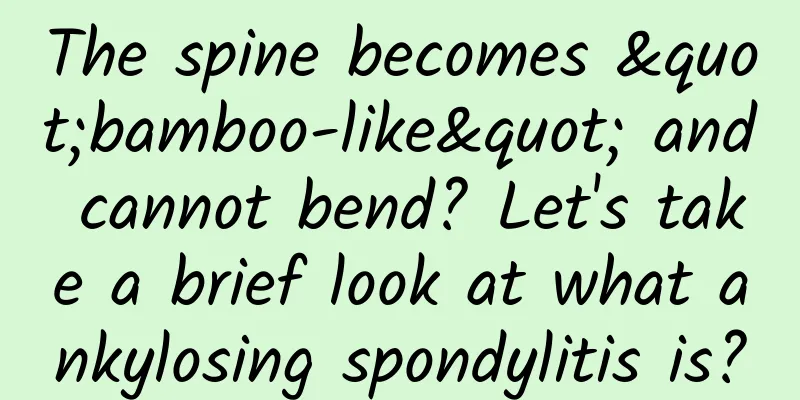The spine becomes "bamboo-like" and cannot bend? Let's take a brief look at what ankylosing spondylitis is?

|
Ankylosing spondylitis (AS) is a chronic inflammatory disease that mainly affects the sacroiliac joints, spine, paraspinal soft tissues and peripheral joints. In severe cases, spinal deformity and ankylosis may occur, the so-called "bamboo spine". The incidence of AS in my country is about 0.3%, with a male-female ratio of about 2-4:1, and the peak incidence is between 18 and 35 years old. Why do people get ankylosing spondylitis? The cause of AS is still unclear, but epidemiological studies suggest that it may be related to genetic and environmental factors. It has been confirmed that human leukocyte antigen (HLA)-B27 is closely related to the onset of AS and has a familial clustering. What are the symptoms of ankylosing spondylitis? 1. Joint manifestations: (1) Inflammatory back pain: manifested as pain at night, aggravated during rest, stiffness in the morning or after sitting for a long time, and these symptoms improve after getting up or moving. (2) Enthesitis: manifested as pain, stiffness and tenderness at the attachment points of the Achilles tendon, plantar fascia, patella, shoulder, costochondral connection, sternocostal joint, sternoclavicular joint and superior iliac crest. (3) Peripheral joint involvement: mainly in the lower limb joints, such as asymmetric joint swelling, pain and limited movement of the knee and ankle joints. 2. Extra-articular manifestations: (1) Eyes: Anterior uveitis is common, manifested by local unbearable pain, congestion, photophobia, tearing and blurred vision. (2) Cardiovascular system: aortic valve insufficiency, conduction disorders, etc. (3) Lungs: pulmonary fibrosis, sometimes accompanied by cavitation. (4) Intestines: Histological examination can detect inflammation of the ileum and colon mucosa, but usually asymptomatic. Some patients may develop Crohn's disease and ulcerative colitis. (5) Nervous system: impotence, nocturnal urinary incontinence, bladder and rectal hypoesthesia, loss of ankle reflexes, etc. may occur. (6) Skin: psoriasis, etc. How is ankylosing spondylitis diagnosed? 1. Laboratory examination: generally non-specific. Although the HLA-B27 positive rate of AS patients in my country is about 90%, positive does not necessarily develop into AS. Similarly, HLA-B27 negative patients also need to be comprehensively evaluated in combination with clinical symptoms and imaging manifestations, and the possibility cannot be directly ruled out. In addition, inflammatory indicators such as elevated erythrocyte sedimentation rate (ESR) and C-reactive protein (CRP) may appear in acute AS. 2. Physical examination: occipital wall test, chest expansion, Schober test, pelvic compression, Patrick test (lower limb "4" test). 3. Imaging examination: (1) X-ray examination: evaluates the degree of sacroiliac joint lesions and has diagnostic significance. (2) CT examination: can clearly show the structural changes of the sacroiliac joint, such as erosion, sclerosis and ankylosis, and its ability to identify structural changes is better than X-ray. (3) MRI examination: can detect sacroiliac joint lesions earlier, showing acute inflammatory changes and structural damage changes, such as bone marrow edema, bursitis, joint effusion, etc. What are the diagnostic criteria for ankylosing spondylitis? The New York criteria for AS revised in 1984 are still used. AS can be diagnosed if the following radiological criteria are met and any one of the clinical criteria is met: What are the treatments for ankylosing spondylitis? 1. Non-drug treatment: (1) Health education: Understand the relevant knowledge of AS, maintain a good attitude, and actively cooperate with the treatment. (2) Maintain a correct posture: stand and sit with your chest up, abdomen in, and eyes looking straight ahead; sleep on a slightly harder bed, with a low pillow, and in a supine position. (3) Keep exercising. 2. Drug treatment: (1) Nonsteroidal anti-inflammatory drugs (NSAIDs): First-line drugs that can improve low back pain, morning stiffness, and joint swelling, such as diclofenac and celecoxib. (2) Biological DMARDs: Suitable for patients whose disease remains active after NSAIDs treatment, including tumor necrosis factor (TNF) α inhibitors and interleukin (IL)-17 inhibitors. (3) Traditional synthetic DMARDs: Can be tried when patients cannot obtain more effective treatment, such as methotrexate, leflunomide, sulfasalazine, etc. 3. Surgical treatment: Spinal correction or joint replacement surgery can be performed for patients with limited function or severe joint deformities. Although there is currently no cure for AS, timely diagnosis and reasonable treatment can effectively control or delay disease progression and improve the quality of life. References: Huang Feng, Zhu Jian, Wang Yuhua, et al. Diagnosis and treatment guidelines for ankylosing spondylitis[J]. Chinese Journal of Internal Medicine, 2022, 61(8): 893-900. DOI: 10.3760/cma.j.cn112138-20211226-00913. |
<<: Can’t move your fingers? Let’s talk about “trigger finger”
Recommend
The clinical symptoms of vulvitis, the following two aspects will help you understand
Nowadays, vulvitis is a common gynecological dise...
Do the shoes you bought really fit?
I want to ask: Do the shoes you bought really fit...
Causes and treatments of vaginal itching during pregnancy
Pregnancy is something every woman will experienc...
Crab is delicious! If you want to eat healthy and have a craving for it, here are the three must-haves
Crab is delicious! If you want to eat healthy and...
Can cat litter be used even if it has grown hair? How to store cat litter that you don't buy?
Cat litter is one of the must-have items for almo...
Picture of bulging belly in early pregnancy
Will the belly bulge out one month into pregnancy...
What is the function of okra mucus? Can okra be eaten raw?
Okra is relatively tender, with soft meat and swe...
What to eat to increase progesterone levels
For pregnant women, progesterone level is an impo...
Can I take a hot spring bath after breast augmentation?
The so-called breast augmentation generally refer...
How to deal with wasp stings
I believe many people are familiar with hornets. ...
Which is more serious, gallstones or gallbladder polyps?
Although both gallstones and gallbladder polyps a...
40-year-old woman with leg cramps
There are many different causes of leg cramps. Ca...
The fastest way for thin people to enlarge their breasts, these are the most recommended
Every woman wants to have a slim figure, but most...
Can postpartum cold be cured?
Postpartum hand colds can be cured and generally ...
Why does breast bumping hurt?
Why does it hurt when your breasts shake? Lobular...









